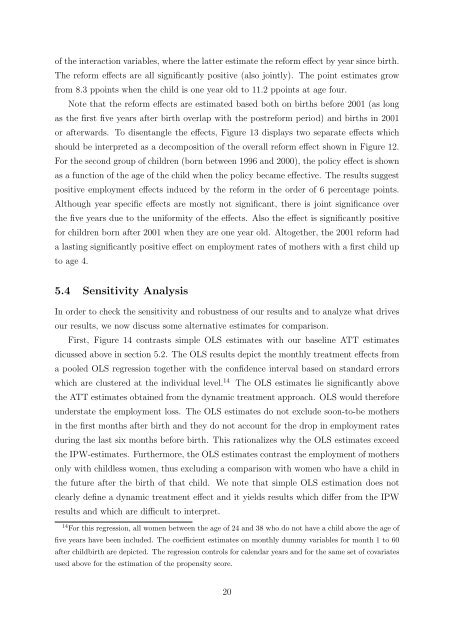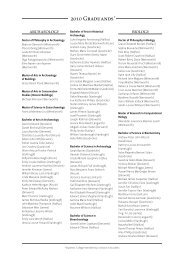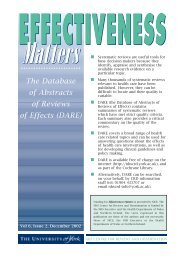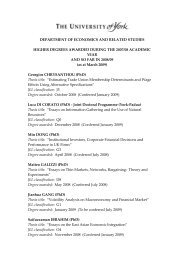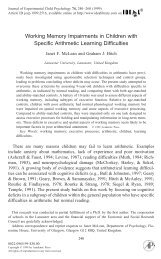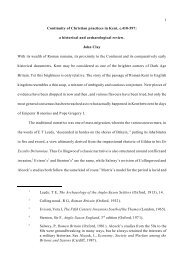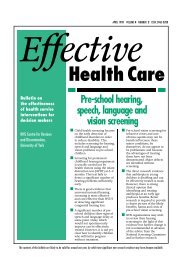Causal effects on employment after first birth - A ... - University of York
Causal effects on employment after first birth - A ... - University of York
Causal effects on employment after first birth - A ... - University of York
You also want an ePaper? Increase the reach of your titles
YUMPU automatically turns print PDFs into web optimized ePapers that Google loves.
<strong>of</strong> the interacti<strong>on</strong> variables, where the latter estimate the reform effect by year since <strong>birth</strong>.The reform <str<strong>on</strong>g>effects</str<strong>on</strong>g> are all significantly positive (also jointly). The point estimates growfrom 8.3 ppoints when the child is <strong>on</strong>e year old to 11.2 ppoints at age four.Note that the reform <str<strong>on</strong>g>effects</str<strong>on</strong>g> are estimated based both <strong>on</strong> <strong>birth</strong>s before 2001 (as l<strong>on</strong>gas the <strong>first</strong> five years <strong>after</strong> <strong>birth</strong> overlap with the postreform period) and <strong>birth</strong>s in 2001or <strong>after</strong>wards. To disentangle the <str<strong>on</strong>g>effects</str<strong>on</strong>g>, Figure 13 displays two separate <str<strong>on</strong>g>effects</str<strong>on</strong>g> whichshould be interpreted as a decompositi<strong>on</strong> <strong>of</strong> the overall reform effect shown in Figure 12.For the sec<strong>on</strong>d group <strong>of</strong> children (born between 1996 and 2000), the policy effect is shownas a functi<strong>on</strong> <strong>of</strong> the age <strong>of</strong> the child when the policy became effective. The results suggestpositive <strong>employment</strong> <str<strong>on</strong>g>effects</str<strong>on</strong>g> induced by the reform in the order <strong>of</strong> 6 percentage points.Although year specific <str<strong>on</strong>g>effects</str<strong>on</strong>g> are mostly not significant, there is joint significance overthe five years due to the uniformity <strong>of</strong> the <str<strong>on</strong>g>effects</str<strong>on</strong>g>. Also the effect is significantly positivefor children born <strong>after</strong> 2001 when they are <strong>on</strong>e year old. Altogether, the 2001 reform hada lasting significantly positive effect <strong>on</strong> <strong>employment</strong> rates <strong>of</strong> mothers with a <strong>first</strong> child upto age 4.5.4 Sensitivity AnalysisIn order to check the sensitivity and robustness <strong>of</strong> our results and to analyze what drivesour results, we now discuss some alternative estimates for comparis<strong>on</strong>.First, Figure 14 c<strong>on</strong>trasts simple OLS estimates with our baseline ATT estimatesdicussed above in secti<strong>on</strong> 5.2. The OLS results depict the m<strong>on</strong>thly treatment <str<strong>on</strong>g>effects</str<strong>on</strong>g> froma pooled OLS regressi<strong>on</strong> together with the c<strong>on</strong>fidence interval based <strong>on</strong> standard errorswhich are clustered at the individual level. 14 The OLS estimates lie significantly abovethe ATT estimates obtained from the dynamic treatment approach. OLS would thereforeunderstate the <strong>employment</strong> loss. The OLS estimates do not exclude so<strong>on</strong>-to-be mothersin the <strong>first</strong> m<strong>on</strong>ths <strong>after</strong> <strong>birth</strong> and they do not account for the drop in <strong>employment</strong> ratesduring the last six m<strong>on</strong>ths before <strong>birth</strong>. This rati<strong>on</strong>alizes why the OLS estimates exceedthe IPW-estimates. Furthermore, the OLS estimates c<strong>on</strong>trast the <strong>employment</strong> <strong>of</strong> mothers<strong>on</strong>ly with childless women, thus excluding a comparis<strong>on</strong> with women who have a child inthe future <strong>after</strong> the <strong>birth</strong> <strong>of</strong> that child. We note that simple OLS estimati<strong>on</strong> does notclearly define a dynamic treatment effect and it yields results which differ from the IPWresults and which are difficult to interpret.14 For this regressi<strong>on</strong>, all women between the age <strong>of</strong> 24 and 38 who do not have a child above the age <strong>of</strong>five years have been included. The coefficient estimates <strong>on</strong> m<strong>on</strong>thly dummy variables for m<strong>on</strong>th 1 to 60<strong>after</strong> child<strong>birth</strong> are depicted. The regressi<strong>on</strong> c<strong>on</strong>trols for calendar years and for the same set <strong>of</strong> covariatesused above for the estimati<strong>on</strong> <strong>of</strong> the propensity score.20


